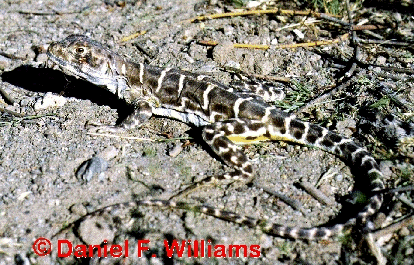The San Joaquin Valley SUN
Sun writer Sam Lewison
Help Us Save The Blunt Nosed Leapord Lizard!!!
 In 1971 the blunt
nosed Leapord Lizard enterd the ranks of the rest of the endangered species
world. Joining 12 other reptiles native to the state of California this species
is now being threatened to extinction by human actions. The consequences of
our desires and construction efforts in the Lizards native home land are creating
disastrous consequences. Around 70% of the leapord Lizards available home land
has been destroyed or made unavailable to them.
In 1971 the blunt
nosed Leapord Lizard enterd the ranks of the rest of the endangered species
world. Joining 12 other reptiles native to the state of California this species
is now being threatened to extinction by human actions. The consequences of
our desires and construction efforts in the Lizards native home land are creating
disastrous consequences. Around 70% of the leapord Lizards available home land
has been destroyed or made unavailable to them.
Known to scientists as the Gambelia Silus, or the San Joaquin Valley Lizard
to others, this reptile has made homes of abandoned squirrels and other various
ìdiggersî of the valley and make good use of its land. They hunt
and eat only prey of appropriate size, mainly insects (i.e. moths, grasshopers,
and crickets) and are absolutley no threat to anything we humans even come close
to associating ourselves with. The males can grow to around 5 inches while the
females are usually smaller. These harmless little creatures come to the planets
surface to mate and hunt durring the warmer months, when temps are regularly
between 72 and 97 degrees farenheit.
When the temps drop, so do the lizards, by making their way undeground into
their tunnels. These lizards have no migrating pattern. Every June or July each
female will lay (usually) a single clutch of anywhere between two to six eggs
and then the incubation period, which lasts about two months is innitiated.
Before we came into their homes and started taking over (much like we always
do) these delightfull little things were only hunted by snkaes, birds of prey,
and other carnivorous valley mammals. This was within a home land that stretched
for hundreds of thousands of miles however! They had practically nothing to
worry about, except within their own relationships. Male lizards are highly
combative with each other and fight over territory and mates. These lizards
have regenerative tails that extend from their body, these tails are usually
a little longer than most lizards and help to differentiate them from other
long nosed lizards or spotted lizards. In 1975 the United States Fish and Wildlife
Services sponsered a recovery team to establish land boundaries on where these
lizards still existed. A final federal Recovery Plan was published in 1981.
A few protected reserves have been established, such as the Allensworth Ecological
Reserve and the Antelope Plains, to help keep the blunt nosed leapord lizard
population up. With only a little over 160, 000 acres to live in and an estimated
.2 lizards per acre, we are not left with many blunts around. They need your
help and so do we if anything more is to be done!
This report was compiled with the assistance of the Habitat Conservation Planning
Branch of the California Department of Fish and Game
 In 1971 the blunt
nosed Leapord Lizard enterd the ranks of the rest of the endangered species
world. Joining 12 other reptiles native to the state of California this species
is now being threatened to extinction by human actions. The consequences of
our desires and construction efforts in the Lizards native home land are creating
disastrous consequences. Around 70% of the leapord Lizards available home land
has been destroyed or made unavailable to them.
In 1971 the blunt
nosed Leapord Lizard enterd the ranks of the rest of the endangered species
world. Joining 12 other reptiles native to the state of California this species
is now being threatened to extinction by human actions. The consequences of
our desires and construction efforts in the Lizards native home land are creating
disastrous consequences. Around 70% of the leapord Lizards available home land
has been destroyed or made unavailable to them.